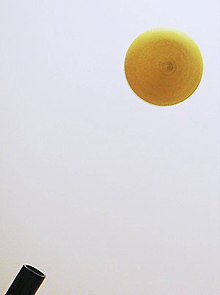Coandův efekt

Coandův efekt (anglicky Coandă effect) je tendence tryskajícího proudu tekutiny (např. vzduchu) „přidržovat se“ konvexního povrchu. Efekt je pojmenován po rumunském vynálezci Henri Coandovi, který jej popsal jako „tendenci proudu tekutiny, tryskajícího z trysky, následovat sousedící plochý nebo zakřivený povrch a vysávat tekutinu z okolí tak, že se vytvoří oblast nižšího tlaku“.[1][2]
Coanda byl prvním, kdo si uvědomil možnosti praktické aplikace tohoto efektu v konstrukci letadel.[3][4] Například sovětský/ukrajinský Antonov An-72 využívá tohoto efektu při ofukování horní strany křídla (motory umístěnými nad křídlem) pro zvýšení vztlaku.[5]
Odkazy
Reference
V tomto článku byl použit překlad textu z článku Coandă effect na anglické Wikipedii.
- ↑ Tritton, D.J., Physical Fluid Dynamics, Van Nostrand Reinhold, 1977 (reprinted 1980), Section 22.7, The Coandă Effect.
- ↑ Definition of COANDA EFFECT [online]. Dostupné online.
- ↑ "The Coanda effect is a phenomenon that was first observed in 1910 by a mathematician and engineer named Henri Coandă. He discovered that when air was ejected from a rectangular nozzle, it would attach itself to an inclined flat plate connected to the nozzle exit. Emphasizing the need for a sharp angle between the nozzle and the flat plate, Coandă then applied the principle to a series of deflecting surfaces, each at a sharp angle to the previous one, and succeeded in turning flows through angles as large as 180. He stated that "when a jet of fluid is passed over a curved surface, it bends to follow the surface, entraining large amounts of air as it does so," and this phenomenon has become known as the Coandă Effect. On Some Recent Applications of the Coanda Effect Caroline Lubert International Journal of Acoustics and Vibration, Vol. 16, No. 3, 2011 http://www.iiav.org/ijav/content/volumes/16_2011_1739941303237209/vol_3/237_firstpage_856831320254369.pdf
- ↑ Coandă effect. (2013). Columbia Electronic Encyclopedia, 6th Edition. Digital version available here: http://www.answers.com/topic/coanda-effect archiveurl=https://web.archive.org/web/20120118131611/http://www.answers.com/topic/coanda-effect archivedate=2012-01-18
- ↑ Skyships Eng: A Revolution in Aviation... or not. The An-72 na YouTube (anglicky)
Externí odkazy
 Obrázky, zvuky či videa k tématu Coandův efekt na Wikimedia Commons
Obrázky, zvuky či videa k tématu Coandův efekt na Wikimedia Commons - (anglicky) Flight 1945
- (anglicky) Coandă effect video (1)
- (anglicky) Coandă effect video (2)
- (anglicky) Information on the patents of Coandă
- (anglicky) New UK based UAV project utilising the Coandă effect
- (anglicky) Report on the Coandă Effect and lift
- (anglicky) How to see the Coandă effect at home (www.physics.org comic)
Média použitá na této stránce
This is an astonishing demonstration of the Coandă effect. The pingpong ball “sticks“ to the lower side of an airstream: The Coandă-Effect (in combination with the Robins-Magnus-effect) deters the ball from falling down, the jet as whole keeps the ball in some distance from the jet exhaust and gravity lets the ball not be blown away. So the ball may stay in a stable position.
